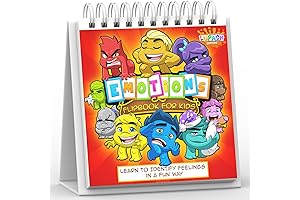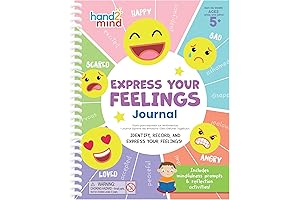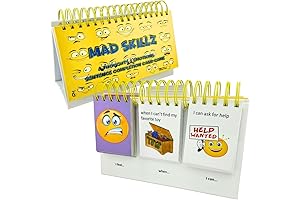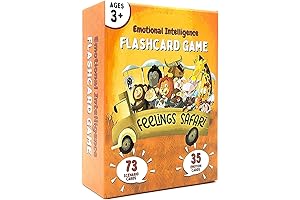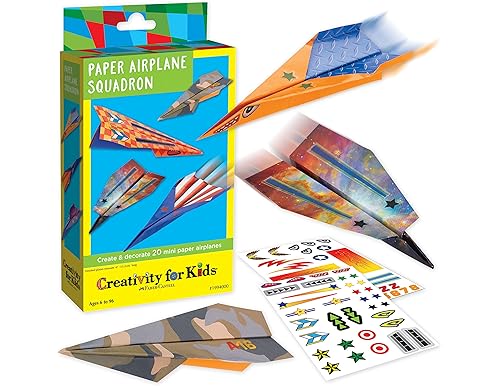· flash cards · 13 min read
Best Feelings Chart For Kids Ages 4-8 (2024): Find Your Ideal Pick
Discover the best feelings chart for kids ages 4-8 in 2024. We've analyzed the top products with expert insights to help you make the right choice for your little one.
Embark on a delightful journey of exploring the best feelings chart for kids ages 4-8. Our top-rated picks guarantee an immersive learning experience, enhancing their emotional intelligence and self-awareness.
Overview

PROS
- Helps children identify and express their emotions effectively.
- Engaging flipbook format fosters interactive learning.
CONS
- May require adult guidance for younger children.
- Content may be limited for children over the age of 8.
The I Know What to Do Flipbook is an invaluable tool for children ages 4-8 to develop their emotional intelligence. Through a series of colorful and engaging pages, kids learn to recognize, understand, and manage their feelings. The flipbook format makes it easy for children to navigate and explore the different emotions, while the simple and relatable language helps them grasp the concepts quickly.
One of the key strengths of this flipbook is its ability to provide concrete strategies for children to deal with difficult emotions. Whether they're feeling angry, sad, or anxious, the flipbook offers practical suggestions to help them calm down and make positive choices. This is particularly valuable for children with autism or other developmental challenges, as it provides them with clear and accessible tools for managing their emotions.

PROS
- Engaging and interactive format helps kids identify, understand, and express their feelings.
- Supports social-emotional learning, enabling kids to develop empathy, communication skills, and self-regulation.
- Durable and child-friendly puzzle pieces withstand frequent use.
CONS
- Some pieces may be too small for younger children, requiring adult supervision.
- Card stock material can be prone to bending, so careful handling is advised.
Our Feelings & Emotions Puzzle Cards are an innovative tool designed to help children ages 4-8 explore the complex world of emotions. These puzzle cards feature engaging and relatable illustrations that represent a wide range of feelings, from happiness and excitement to sadness and anger. By matching the puzzle pieces correctly, kids can learn to identify, understand, and express their own feelings, as well as the feelings of others.
These cards are not just a fun and engaging activity; they also serve as a valuable educational resource. They support social-emotional learning, a crucial aspect of child development that helps kids build empathy, develop communication skills, and learn self-regulation. By playing with these puzzle cards, kids can develop a deeper understanding of their own emotions and those of others, fostering healthy emotional intelligence and social development.

PROS
- Comprehensive set of 48 puzzle cards featuring diverse emotions and scenarios.
- Developed by educational experts to enhance social-emotional learning.
CONS
- May require parental guidance for younger children to fully understand the concepts.
- Some cards may be too advanced for younger kids.
If you're searching for an engaging and educational tool to help your youngsters navigate the intricate world of feelings, look no further than the Learning Resources Feelings & Emotions Puzzle Cards. This exceptional set of 48 puzzle cards is a treasure trove of vibrant images, relatable scenarios, and expert insights, specifically crafted to support children ages 4-8 in understanding, identifying, and expressing their emotions.
Each puzzle card presents a different emotion, from happiness and excitement to sadness and anger. Children are tasked with matching the emotion word with the corresponding image, fostering their recognition and vocabulary skills. As they piece together the puzzles, they're also encouraged to discuss the scenarios depicted, promoting healthy emotional expression and empathy. The puzzle format adds an element of fun and interactivity, making learning about feelings an enjoyable experience.

PROS
- Empowering kids with a comprehensive visual guide to 20 distinct emotions
- Promoting emotional literacy and coping skills to navigate challenging feelings
CONS
- Limited availability of physical copies
- May require parental guidance for younger children
This feelings flipbook, crafted by experienced therapists, is an invaluable resource for children aged 4-8 and beyond. It provides a comprehensive visual guide to 20 different emotions, fostering emotional literacy and equipping kids with the language to express their feelings. The age-appropriate illustrations and simple explanations make it accessible and engaging, helping children understand the nuances of complex emotions.
This flipbook goes beyond mere identification by delving into coping strategies and tools for managing challenging feelings. It offers practical tips on navigating anger, expressing empathy, and developing self-regulation skills. By mastering these techniques, kids can build resilience, improve social interactions, and increase their overall well-being. The flipbook's portability makes it a convenient companion for both home and school environments, empowering children to explore their emotions anytime, anywhere.

PROS
- Colorful and engaging activities
- Helps kids express their feelings in a fun and interactive way
- Promotes emotional awareness and coping mechanisms
- Perfect for children ages 4-8
CONS
- Paper quality could be improved
- Some of the activities may be too simple for older children
The Express Your Feelings Journal is a great tool for teaching kids about their emotions. It includes a variety of activities, such as a feelings wheel, journaling prompts, and coloring pages. The activities are fun and engaging, and they help kids to identify and express their feelings in a healthy way. The journal also provides information about different emotions, which can help kids to understand their own emotions and the emotions of others.
The Express Your Feelings Journal is a great way to help kids develop their emotional intelligence. Emotional intelligence is the ability to understand and manage one's own emotions, as well as the emotions of others. It is an important life skill that can help kids succeed in school, work, and relationships. The Express Your Feelings Journal can help kids to develop their emotional intelligence by teaching them about their emotions, how to express them in a healthy way, and how to cope with difficult emotions.

PROS
- Empowering kids ages 4-8 to express their emotions effectively
- Interactive card game fostering self-awareness and emotional regulation
- Perfect for teaching mindfulness and positive decision-making
- Helps children develop empathy and social skills
- Durable laminated cards and hardcover guide for longevity
CONS
- May require some guidance for younger children
- Some parents may prefer a more comprehensive emotional regulation program
Embark on a journey of emotional discovery with Thought-Spot, a captivating card game designed specifically for children aged 4-8. This innovative game acts as a feelings chart for kids, providing a fun and engaging platform for them to recognize, label, and express their emotions. Through a series of thought-provoking sentence completion prompts, children are guided towards self-awareness, fostering emotional regulation and positive decision-making.
Thought-Spot is not just a game; it's an invaluable tool for nurturing emotional intelligence in young minds. By playing, children learn to identify their feelings, articulate them with ease, and understand the impact of their emotions on their actions and relationships. Moreover, the game emphasizes the importance of mindfulness, encouraging children to pause, reflect, and make choices that align with their values and goals.

PROS
- Encourages self-awareness and emotional literacy in young children.
- Provides a fun and interactive way for kids to identify and express their emotions.
CONS
- Some children may find the chart too abstract.
- The chart requires adult guidance to maximize its effectiveness.
Kickstart your child's emotional intelligence journey with our vibrant Mindful Feelings Chart! Designed specifically for kids aged 4-8, this chart is a playful and engaging tool that empowers young minds to recognize, understand, and express their emotions.
With its captivating imagery and simple language, this chart transforms emotional literacy into a delightful adventure. The color-coded faces and everyday scenarios resonate deeply with children, making it easier for them to pinpoint their own feelings and communicate them effectively. This fosters self-awareness, empathy, and strong emotional bonds with parents and peers.

PROS
- Helps kids identify and understand their emotions.
- Promotes empathy and social skills.
- Learning through a fun and engaging game.
- Suitable for toddlers & children with special needs.
CONS
- May require adult guidance for younger children.
- Some scenarios may not be relatable for all kids.
Feelings in a Flash, the emotional intelligence flashcard game, offers a dynamic way to introduce children ages 4 to 8 to the recognition, interpretation, and expression of their feelings. Consisting of 50 scenario cards and 50 corresponding facial expressions, this engaging game provides a fun and interactive platform for kids to learn about emotions and their impact on others.
The game challenges players to identify and match emotions, fostering empathy and social skills. It cultivates an understanding of how different situations can evoke various feelings and guides children through appropriate reactions. Moreover, Feelings in a Flash can be particularly beneficial for toddlers and children with special needs, enabling them to grasp social cues and navigate emotional landscapes with greater ease.

PROS
- Expansive set of 108 cards covering a wide range of feelings and emotions.
- Engaging visual aids showcasing diverse facial expressions and relatable scenarios.
- Interactive and child-friendly design promotes active participation and skill development.
CONS
- Some advanced emotions may be challenging for younger children to grasp without additional support.
Designed for children ages 4-8, this comprehensive feelings chart flashcard game offers a fun and engaging way to enhance emotional intelligence. With 108 cards in the box, kids are introduced to a vast spectrum of feelings and emotions, from basic ones like happy and sad to more nuanced ones like proud and guilty. The cards feature vivid images displaying diverse facial expressions and relatable everyday scenarios, making them visually appealing and easy to comprehend.
Beyond simple recognition, the game encourages interactive learning through discussion prompts and role-playing activities. Kids can express their own feelings, interpret those of others, and develop coping mechanisms for handling difficult emotions. This playful approach fosters self-awareness, empathy, and a deeper understanding of the emotional world around them. While some advanced emotions may require additional guidance for younger children, the versatility of this game allows for customization based on each child's developmental stage.

PROS
- Encourages open communication about feelings, fostering emotional literacy.
- Provides a fun and engaging platform for children to learn and practice managing their emotions effectively.
- Supports social skills development, teaching kids empathy and perspective-taking.
CONS
- Some children may struggle to grasp the abstract concepts of emotions initially.
- May require adult guidance to facilitate meaningful discussions and ensure children fully comprehend the emotional concepts.
The Connect 4 Feelings board game is an innovative and engaging resource for children ages 4-8 to explore and develop their understanding of emotions. This game features a unique combination of Connect 4 gameplay and 56 emotion cards, creating a fun and interactive environment for kids to learn about emotions, develop empathy, and practice emotional regulation.
The game's easy-to-follow rules make it accessible for young children, while its engaging gameplay keeps them entertained and motivated to play. As kids take turns dropping their colored discs into the game board, they select an emotion card and discuss the emotion depicted on the card, sharing their own experiences and perspectives. This process encourages open communication about feelings, helping children to build emotional vocabulary and express themselves effectively.
Whether you seek to nurture your child's emotional vocabulary, foster empathy, or provide a calming tool for challenging moments, our carefully curated selection of feelings charts caters to your specific needs. Discover the perfect fit to support your child's emotional growth and well-being today!
Frequently Asked Questions
What is the importance of using a feelings chart for kids ages 4-8?
Utilizing a feelings chart for kids ages 4-8 offers numerous benefits. It promotes emotional recognition and expression, enhances vocabulary related to emotions, fosters empathy and understanding of others' feelings, and empowers children to effectively regulate their emotions.
How can a feelings chart for kids ages 4-8 benefit my child's development?
A feelings chart for kids ages 4-8 serves as a valuable tool for their emotional and social development. It assists in identifying and labeling emotions, promoting emotional regulation and self-awareness, fostering empathy and social skills, and supporting overall well-being.
What features should I look for when selecting a feelings chart for kids ages 4-8?
When choosing a feelings chart for kids ages 4-8, consider factors such as age-appropriateness, visual appeal, durability, and ease of use. Opt for charts that feature clear and recognizable images, offer a range of emotions, and are made from sturdy materials that can withstand frequent use.
How can I use a feelings chart for kids ages 4-8 effectively?
To effectively utilize a feelings chart for kids ages 4-8, engage your child in interactive activities. Discuss the different emotions depicted, practice identifying and labeling emotions, and encourage them to express their feelings using the chart. Make it a fun and engaging experience for optimal learning and emotional growth.
What are some tips for introducing a feelings chart to kids ages 4-8?
Introducing a feelings chart to kids ages 4-8 should be a gradual and interactive process. Start by presenting a few basic emotions, using clear and simple language. Encourage your child to share their feelings and experiences related to each emotion. Gradually introduce more complex emotions as their understanding grows.



